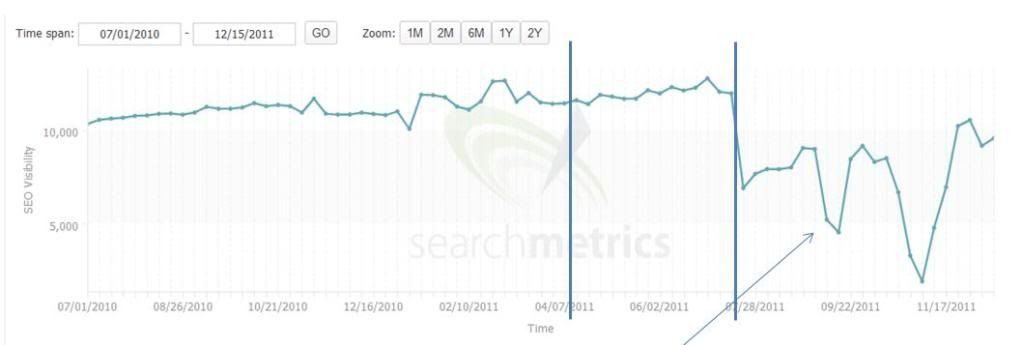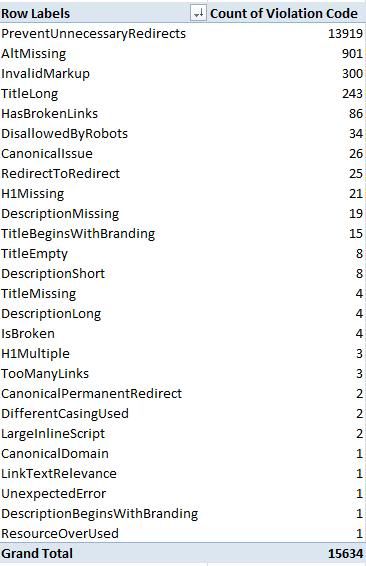 Google's Panda update was a direct attack on bad content, which comes in many different flavours, including duplicate, weak, thin and template.
Google's Panda update was a direct attack on bad content, which comes in many different flavours, including duplicate, weak, thin and template.
Panda acts like a domain wide penalty, so your whole site is affected and your good pages are dragged down by your bad pages.
This is a guide on how to find and fix Google's Panda algorithm update, based on our Panda fighting experience at SEOgadget in 2011.
Panda basics
- Panda is about dealing with bad content, not bad links. Bad content comes in different flavours: duplicate, weak, thin and template
- Panda acts like a domain wide penalty: your whole site is affected and your good stuff is dragged down by your bad stuff
- Web crawler accessibility issues affect how search engines see, and therefore assess, your content.
Often, badly designed Information Architectures compound the problems with already week content
Large sites that have many pages, templated content and lots of sub-categories are the most at risk. If you haven't been monitoring and fixing your accessibility issues, as highlighted in Google Webmaster Tools, you are at risk.
Panda examples
All of these examples are from the UK, mostly from the employment and gift sectors
Classic Panda
We use Searchmetric's SEO visibility score to find out just when sites got hit, or recovered from Panda,
There are three dates that stick out in the UK data:
- Early April was the big UK introduction of Panda.
- There is a smaller inflection in July.
- There is a bigger inflection in October.
You can see in this graph that they are trying to fix their Panda issues but haven't yet bitten the bullet and made the leap they need to:
I know these guys well. They have no idea this data exists or anything about panda, but they have done OK.
One might argue that they are OK because they couldn't care less about SEO and have a product that people like:
It would be easy to attribute this to Panda, but this looks more like developer or general website issues:
One of my favourites from the Employment industry, which clearly shows winners and losers:
I love the green line. Did they even know they had benefited from Google Panda? Did they think they had done something to deserve the new traffic?
Was it all Champagne, cocaine and cash bonuses and then three months later, the next panda update smacks them?
With Panda thinning out sites in a vertical, it creates a false sense of success for the winners, as they themselves may be next in line for the chopping block...
The blue line benefits from the first Panda update and then it looks like they get hit by Panda a few months later, but I don't think that's Panda, I think that's development gone wrong.
Panda smacks and recovery are one day to the next, not across a number of weeks.
The other effect of Panda: the big brands got bigger
Given this graph, where would you go to look for examples of sites that are being rewarded by Google Panda?
Find the websites that benefitted from Panda and look at their content, as that is now the new minimum level of content quality in your industry.
Panda recovery
This data is for Prezzybox, who we worked with. Panda recovery is possible, but a lot of unplanned, un-budgeted blood, sweat, tears and money went into that dip and recovering the traffic.
The SEO visibility metric is a proprietary metric, but I asked Steve Overton from Searchmetrics if he could give us some more insight into it and he has explained the algorithm behind it:
Observations from fighting Panda
Panda is confusing if you are not on top of your data and industry news. There were so many updates it becomes easy to blame everything bad on Panda.
Conversely there are sites which benefitted from Panda but did not attribute it.
When we started exploring how to fix Panda, we moved quite conservatively. Now we suggest that people take strong, decisive action in resolving issues.
Google Panda doesn't fix itself, you have to fix it. It will take time, money and effort. It also requires a change in how you see your online business.
You can make this whole process a lot easier on your business if you put a person in charge of content, and give them a budget and developer time.
The advice is quite simple, concentrated around a few key areas. The implementation is where companies fall down. Fixing Panda is not complex, but it does require a lot of work.
How to fix Panda
Duplicate content
Give someone the responsibility to hunt down duplicate content. Use Google Webmaster tools or SEOmoz tools or Xenu or an IIS crawl (or whatever people suggest in the blog comments).
It's not tough to do, it just requires some concentrated effort
Solve duplicate content issues with rel=canonical. Here are seven short videos of Google's Matt Cutts talking about different aspects of implementing rel=canonical.
Thin content
If you have a section that is just thin templated content, it is hurting the good contents' ability to rank. Be strong and cut the crap or add to your content to improve it.
Cutting the crap
404 a bad section or area and after the pages have dropped out of the index, 301 them somewhere good so you don't lose any incoming link juice.
This is potentially the biggest win.
SEOmoz has a good guide to 301s, including links to references for 301s under Apache and IIS.
Making your content great
There is no getting around the fact that time and effort is needed here. Someone in your organisation needs the time and responsibility to sit down and create great content or manage the creation process via third party writers.
I believe that great content requires both qualitative and quantitative research and a knowledgably person to knit it together to suit both users and search engines.
Here is my guide on taking mediocre content and making it great content and an overview from our work on Panda on how Google might interpret content quality signals.
Templated content
Write content, hire interns or find people in cheaper parts of the world. Many companies are unnecessarily precious about their content and ultimately this ends up hurting more than helping them.
Elance, Odesk and Copify all work for building out content. (Remember, you now have a person responsible for content quality who will oversee this).
Accessibility issues
Run an IIS crawl to find your accessibility issues (IIS is easier to use than you think).
Here is an example list of errors from an IIS crawl. This becomes your plan of attack for clearing up accessibility issues:
You will end up with a list of issues and the urls where those issues are occurring, to be able to go and fix them.
Three key takeaways
The world is not as it once was.
Crap websites trying to masquerade as decent websites are being hunted down and sunk below the quality line.
Google owes you nothing.
Tactics to just barely raise your quality enough to recover your rankings are unlikely to pay dividends. You may well find yourself a loser again the next time the quality bar is raised.
Google is judging you.
Google is going to continue to raise the quality bar with future updates. When your competitors improve their websites, you will be weakest and in line for the chop at the next quality update.
I hope this post helps you decide to build great content today, so you dont have to deal with the fallout from bad content tomorrow.(Image credit: tanakawho via Flickr)
Stephen Croome is Head of SEO Delivery at SEOgadget and a guest blogger on Econsultancy.








No hay comentarios:
Publicar un comentario